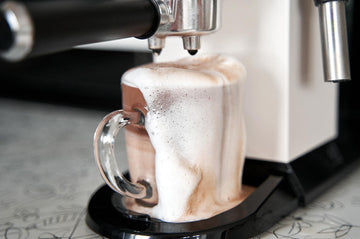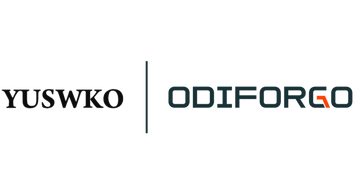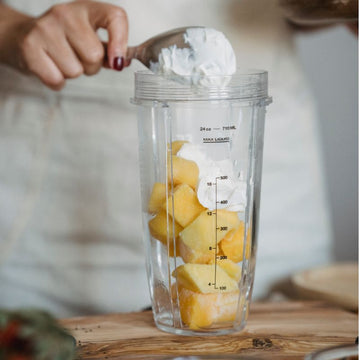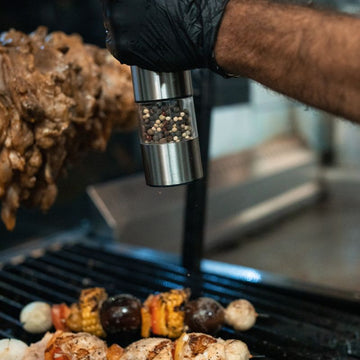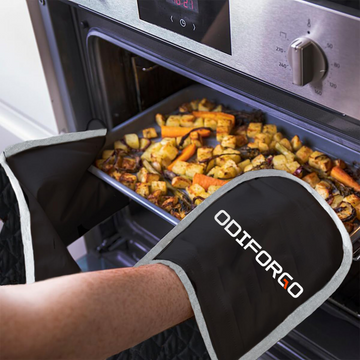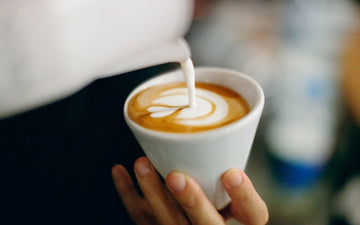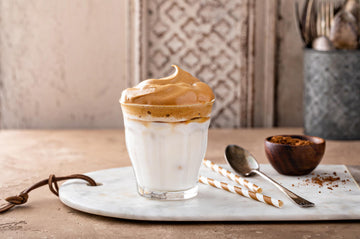Electric milk frothers are everywhere lately. Tucked into kitchen corners, featured in coffee reels, and quietly replacing steam wands for many home setups. They aren’t new, but their recent rise in popularity has made them more than just a gadget for coffee lovers.
Compact, fast, and often surprisingly versatile, electric frothers can do more than just make foam. In this article, we break down what they are, how they work, and what you should realistically expect if you're considering adding one to your kitchen.
What is an electric milk frother?
An electric milk frother is a kitchen appliance designed to aerate milk, turning it into a rich, creamy foam used in drinks like cappuccinos, lattes, and hot chocolate. Unlike manual frothers or steam wands that require more effort or a full espresso machine, electric frothers are typically standalone devices that automate the frothing process with the push of a button.
Electric frothers come in two main designs: handheld (which usually resemble small electric whisks) and countertop models with a built-in container. Most countertop frothers can both heat and froth milk simultaneously, making them convenient for hot beverages, though many also have cold froth settings for iced drinks.
The device works by rapidly spinning a small whisk or agitator inside a chamber, introducing air into the milk. This process changes the texture of the milk, creating a foam that’s light, velvety, and stable enough to top off your drinks or even create simple latte art.
Electric frothers are valued for their consistency, ease of use, and speed. Typically producing results in under two minutes without requiring any barista-level skills.
How does an electric froth work

At its core, an electric milk frother uses mechanical agitation to transform liquid milk into a light foam. Inside the frother, a small whisk or spinning disc. Often magnetic or motor-driven, rotates rapidly, pulling air into the milk. This movement stretches the proteins in the milk, trapping air and forming bubbles, which result in that familiar creamy froth.
In countertop models, the process is usually enclosed within a metal or non-stick container. These units often come with different settings, allowing you to choose between hot froth, cold froth, or simply warming the milk. The heating is typically handled by an induction plate or internal heating element, which ensures even temperature control and helps improve foam stability.
Some electric frothers also let you swap out the whisk attachments for different froth textures: fine and dense, or light and airy. Depending on what your drink calls for.
Handheld frothers, while more basic, use a similar mechanism. You insert the spinning whisk directly into a cup or pitcher of milk, and the spinning motion froths the milk manually. They don’t heat the milk on their own, so if you want warm foam, you’ll need to preheat the milk separately.
In both types, the key is how air is introduced and how well the milk’s proteins and fats stabilize it. Meaning the results can vary based on milk type, temperature, and frothing time.
Types of electric milk frother
Electric milk frothers come in a few key types, each suited to different needs, kitchen setups, and drink styles. While they all share the same goal of turning milk into froth, they differ in how they operate and the kind of results they offer.
Standalone frothers
These are self-contained appliances that heat and froth milk automatically with just the push of a button. They usually have a built-in jug or container with a non-stick interior, and often come with interchangeable whisk attachments for creating different textures (light foam vs. dense foam). Many also let you choose between hot and cold frothing modes. These are ideal for those who want consistency and minimal effort.
Handheld frothers
Smaller, wand-like devices that look like battery-powered whisks. These don’t heat the milk but are great for frothing small amounts quickly. They require you to warm the milk separately if hot foam is your goal. While they’re not as consistent as countertop models, they’re portable, affordable, and easy to clean. Perfect for casual, quick use.
Multi-function frothers
Some higher-end espresso machines or coffee stations come with built-in electric frothing systems. These combine the heating, whisking, and sometimes even milk dispensing in a single machine. While more expensive and bulky, they offer a seamless café-like experience, especially if you’re already invested in espresso-making gear.
Frothing lids for coffee makers

A less common but emerging option: some coffee makers now come with detachable electric frothing lids. These work similarly to standalone models, though they might have fewer settings. They’re good for those who want an all-in-one machine but are tight on space.
Each type has its place depending on how often you use it, how much control you want over the froth, and whether heating milk is a must-have feature. The key is matching the frother to your habits. Not the other way around.
Common use for electric milk frother
Electric milk frothers may seem like a niche gadget, but their versatility makes them surprisingly useful across a variety of drinks and kitchen routines. While most people associate them with cappuccinos or lattes, they can do far more than just coffee.
Lattes, Cappuccinos, and Macchiatos
The most obvious use case is crafting milk-based coffee drinks at home. A quality frother can replicate café-style foam. Either dense and velvety or light and airy, depending on the drink you're aiming for. For lattes, you’ll want a silky microfoam that blends smoothly with espresso. For cappuccinos, a stiffer foam gives that classic layered look and feel.
Cold Foam for Iced Drinks
Many electric frothers offer cold frothing modes. This is ideal for creating cold foam to top iced coffees or matcha lattes. Cold foam gives texture and body without watering down your drink, unlike traditional cream or milk.
Matcha, Chai, and Hot Cocoa
A frother isn’t limited to coffee. You can use it to whisk matcha evenly, blend powdered chai into milk, or create a frothy hot chocolate. The gentle agitation mixes powders thoroughly and adds a creamy finish without a blender.
Protein Shakes and Health Drinks
Handheld frothers, in particular, are great for mixing protein powders, collagen supplements, or other health drink powders into milk or water. They prevent clumping and save you from shaking a bottle for minutes.
Culinary Applications
Beyond drinks, some home cooks use milk frothers for light culinary tasks. Such as emulsifying salad dressings, frothing cream for desserts, or creating foams for plating.
In short, while its core function is to froth milk, an electric milk frother can play a quiet but
Choosing the right milk frother
Not all electric milk frothers are created equal, and choosing the right one depends largely on your preferences, habits, and how you plan to use it. From the texture of the foam to cleaning requirements, here are the key features to consider before making your pick.
Some frothers only create one type of foam, while others offer settings for both dense and airy textures. If you enjoy switching between cappuccinos and lattes, or experimenting with cold foam for iced drinks. Look for a model that allows multiple frothing modes.
Heating functionality
Many standalone electric frothers heat the milk as they froth, which is essential for warm drinks. However, not all models support cold frothing. If you like iced beverages or want to use your frother for matcha or cold brews, check for dual temperature settings.
Capacity
Consider how much milk you typically use. Most electric frothers have a maximum fill line that’s lower when frothing (since milk expands). If you're making drinks for more than one person, choose a model with a larger jug. Handheld frothers are great for single servings but not ideal for volume.
Cleaning and maintenance
Non-stick interiors are common and make cleaning easier, but not all frothers are dishwasher safe. If low-maintenance is a priority, look for removable components or self-cleaning functions. Handheld frothers typically require only a rinse under water.
Build quality and materials
Plastic-bodied frothers are lightweight and often budget-friendly, but stainless steel or metal builds tend to be more durable and retain heat better. If aesthetics matter to you, also consider the finish. Some designs match modern or minimalist kitchens better than others.
Noise and speed
Some frothers operate more quietly than others. If you're brewing coffee in a shared or quiet space, check for user reviews on noise levels. Likewise, look at how fast the frother completes its cycle. Some models take 30 seconds, others up to 2 minutes.
Power source
Most standalone frothers plug into an outlet, while handheld ones are usually battery-operated or USB-rechargeable. If portability is important, like for office use or travel. A battery-powered frother might suit you better.
Electric vs manual milk frother
Milk frothers come in two major categories: electric and manual, and each offers a very different experience. Understanding the differences helps you decide which one better suits your habits, kitchen setup, and how hands-on you want to be.
Electric milk frothers
Electric frothers automate the process. Just pour in your milk, press a button, and let the machine take care of everything. Heating, spinning, and frothing. Some models even let you choose between hot and cold foam or different textures.
Best for
-
Consistency and ease
-
Making multiple drinks quickly
-
Users who prefer convenience over control
Considerations
They require a power source and tend to take up more space. Some models are also pricier, especially those with advanced settings.
Manual milk frothers
Manual frothers, on the other hand, rely on elbow grease. They typically come as plunger-style pitchers or handheld whisks. You heat the milk yourself, then pump or whisk to create foam.
Best for
-
Users who want more control or minimal appliances
-
Smaller kitchens with limited outlets or space
-
Budget-conscious buyers
Considerations
They demand more effort and don’t always produce the same smooth, café-style foam as electric versions. But for some, the hands-on method is part of the charm.
So, which should you choose?
If you want a no-fuss way to enjoy frothy drinks at home, especially daily, electric frothers are a time-saving favorite. If you’re more of a weekend experimenter, or just want to keep it simple and compact, manual frothers might be enough.
Is a electric milk frother right for you?
Whether you're crafting a velvety cappuccino or just want to liven up your morning coffee, a milk frother can elevate your at-home drinks. Electric options offer speed and consistency, while manual frothers keep things simple and hands-on.
Understanding your routine, space, and drink preferences is the key to finding the right fit. There’s no one-size-fits-all answer, but with the right tool, every cup gets a little closer to café-quality. If you are looking for a quality tool for your frothing journey, the Odiforgo milk frother may be your best bet.

